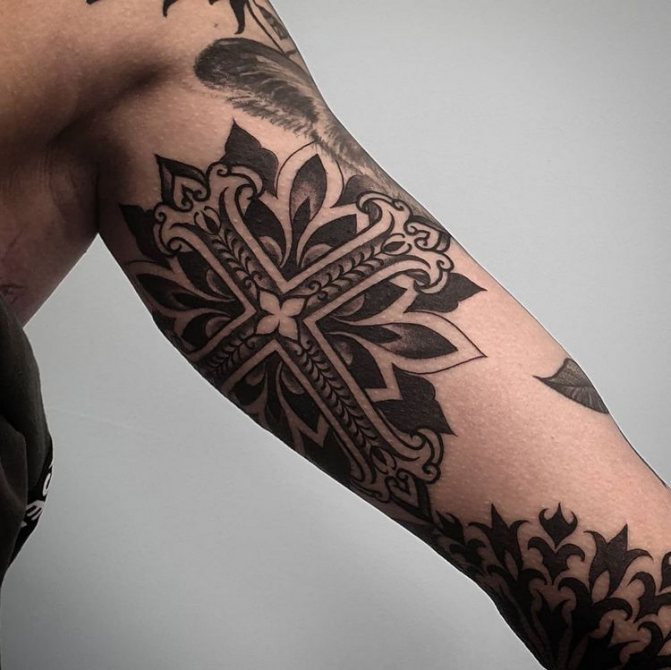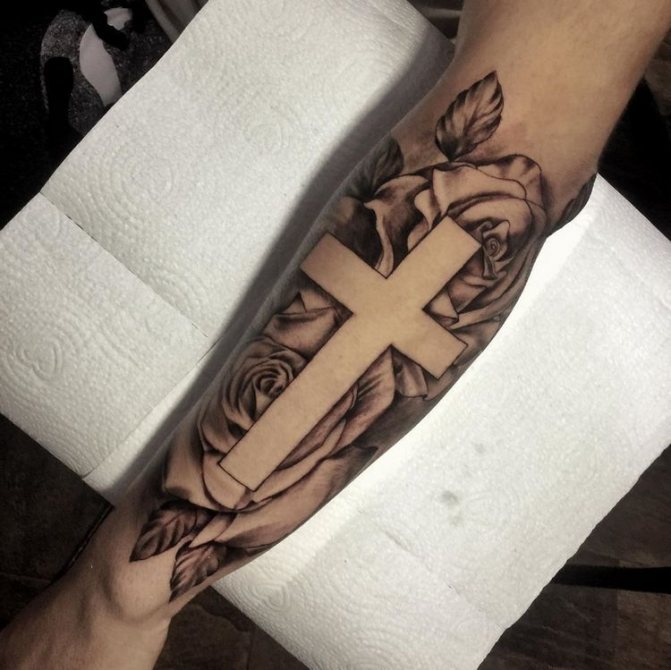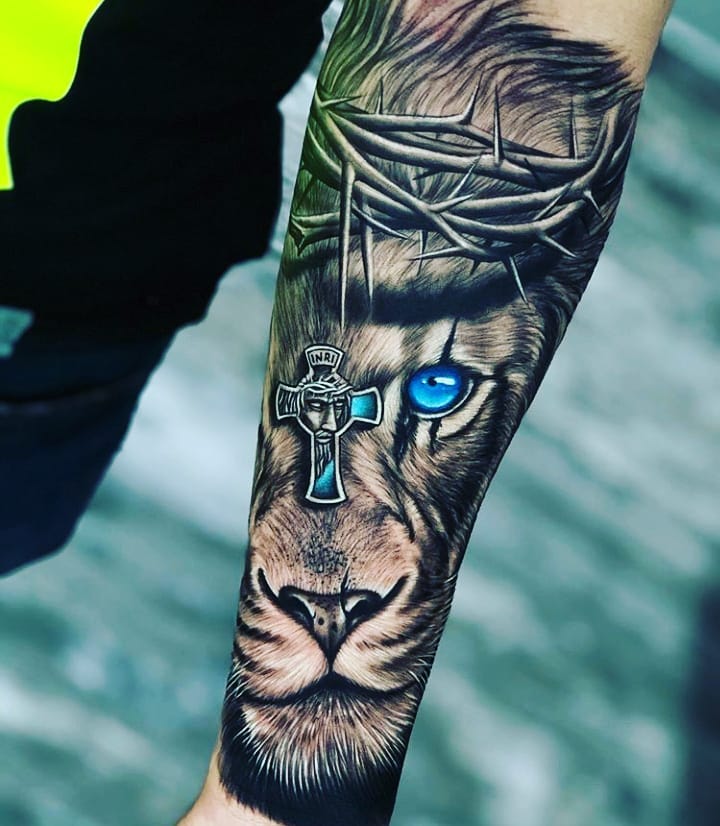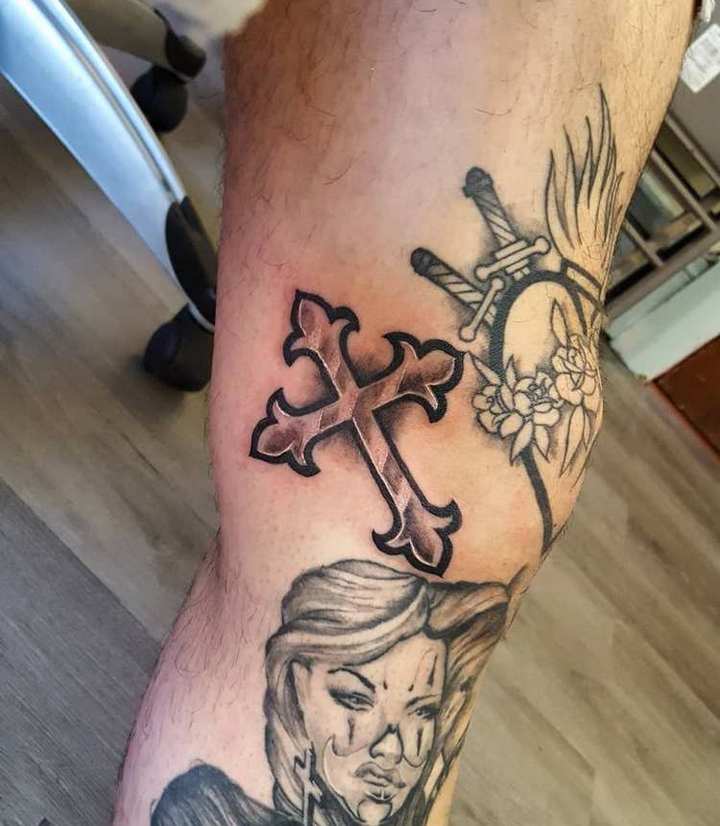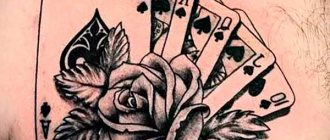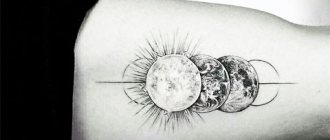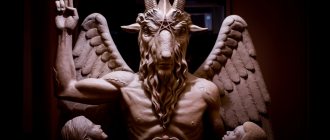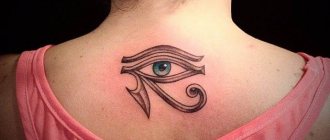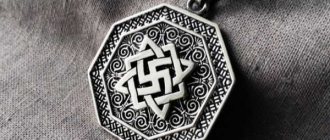The cross as a symbol has a very long and interesting history. It is found in many cultures, carries different meanings, depending on the species, but is always a cult sign.
The ancient Egyptian ankh, the Babylonian cross enclosed in a circle, the solar cross, the cross of the Apostle Peter and many more types used from the pagan tradition to the Christian one.
The main ancient meaning of the tattoo cross is that it is a symbol representing the sun. As various mythologies and religious beliefs, cultures and subcultures evolved, it grew into more and more symbols, and all of them were retained.
Historically, even symbols that we no longer perceive as a cross, such as the swastika or the designation of the "clubs" card suit, are its symbols. Each additional line, circle, pattern on it carry its own sacred meaning, so if a person wants to make a tattoo with its image, you need to carefully consider what exactly it will mean.
What can the tattoo mean?
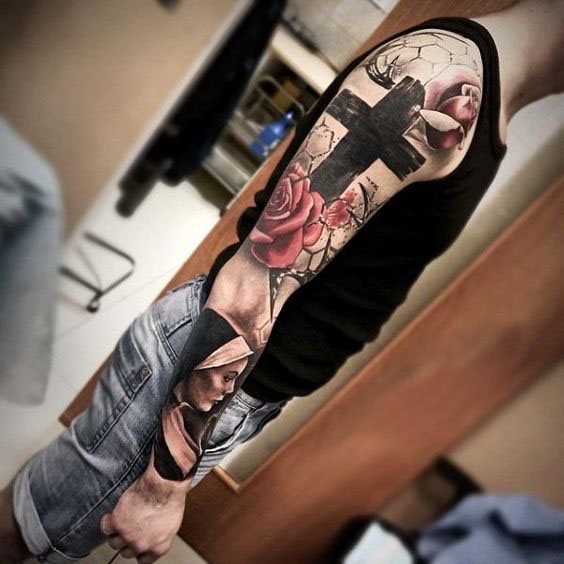
As mentioned above, the meaning of the cross tattoo can encapsulate a range of meanings, depending on its form and type. But there are a number of universal meanings, which in the process of assimilation of cultures have already become universal:
- a symbol of the sun;
- the symbol of life;
- a symbol of the resurrection from the dead;
- masculine and feminine (vertical and horizontal lines, respectively);
- phallic symbol, i.e. the symbol of masculinity, fertility;
- north, south, west, east;
- In some cultures a symbol of the moon;
- belonging to Christianity.
Meaning of the Celtic cross tattoo
This sign has quite longstanding pagan roots, but now it is associated with Celtic Christianity and is its main symbol. Traditionally, the tattoo means:
- worship of St. Patrick;
- "the sun of faith," unclouded faith in God;
- spiritual development;
- the power of faith;
- the union of the spiritual and bodily.
Celtic, thanks to its long history, full of meaning and aesthetically appealing appearance (Celtic patterns have always attracted people's attention), has often been used as a symbol of political and subcultural movements.
So it was a symbol of the neo-fascists, the Nazis, and entered the Gothic subculture, as harmoniously woven into both the external style of the Goths, and their passion for spiritual and philosophical practices.
Varieties
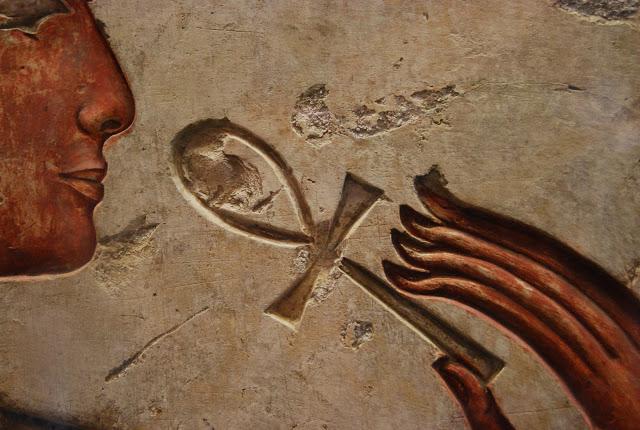

Ancient Egypt, the Orient, Asia and Europe introduced the symbol of the cross at the beginning of civilization. Since then, it has been transformed, transformed, as has its meaning with the appearance of new attributes. The Egyptians are more familiar with the ankh, which combines a circle and the tau-cross, drawn without an upper line. There are many other varieties of the symbol: the Latin, Maltese, patriarchal, papal, Orthodox, Masonic, Celtic, and Constantine cross. The swastika also refers to its varieties, only with bent edges. Maltese, Masonic, iron, as well as all the well-known red and pacifist crosses are considered symbols of various organizations and groups.
Meaning of the Latin cross tattoo
The Latin cross is a simple intersection of two bars. The horizontal one divides the vertical one into two unequal parts, the upper one being shorter.
He is a sign of the Western European Christian faith. On such a cross, according to tradition, Jesus was crucified. That is why it is the one most often associated with Christianity in its modern form and endowed with such meanings as:
- the power of faith;
- resurrection;
- eternal life, etc.
Other uses
Typographic cross
Main article: Typographic cross
The typographic sign of the cross †
Is shaped exactly like a Latin cross. It is often used in various fields:
- This cross is used on maps to indicate the locations of churches.
- It is placed next to a name or date to indicate the death of a person.
- It may denote footnotes.
On flags.
The Latin cross is used on several flags: Recife (Brazil), Pernambuco (Brazil), Tucumán (Argentina). In addition, a long cross turned 90° to the left, called the Scandinavian cross, this cross is located on the flags of many countries, territories and peoples, in particular the flags of the Nordic countries - Norway, Sweden, Denmark, Finland and Iceland.
The meaning of the tattoo Black cross
Black massive cross - it is peculiarly played exactly in the art of tattoo symbol of Christianity as not only the resurrection and eternal life, but also suffering for the faith, the indestructibility of faith.
Massiveness and black symbolize gravity, so a person with such a tattoo takes the moral obligation to "bear his cross", no matter how heavy it was, to the last and without complaining about fate. This is a very strong symbol, when applying it is worth very well think about whether it is feasible for you?
The Latin group of crosses
The Latin group opens the Latin cross (see article for photo). Others from this group are: the seven-pointed and eight-pointed, the Holgothic, the patriarchal, the trefoil, the drop-shaped, the crucifix, and the Antonite. The first four of the list belong to Orthodoxy. The drop-shaped evangelical by history has this shape because of the drops of Christ's blood that sprinkled on the cross at his crucifixion. The Antonian cross is made in the shape of a "T", in the Roman Empire it was attributed to the time of ancient Egypt and the prophet Moses, executing criminals on it. The crucifix dates back to the fifth century, its purpose is not just to be a symbol of faith, but also to be a reminder of the suffering that Jesus Christ had to go through.
Meaning of the inverted cross tattoo
The inverted cross has two meanings. Not just different, but opposite in essence.
First, it is a symbol of the Apostle Peter, the keeper of the keys to paradise. He is holding an inverted cross as a symbol of a sword. This seems strange because Christianity seems to be a peace-loving religion, but we must remember that it is also contradictory. "I bring you not peace, but a sword." In the sense of the apostle Peter's cross, such a tattoo would mean:
- access to secret knowledge;
- the ability to fight for the faith;
- the search for the "keys to heaven," a better life.
At some point in history, Satanists began to use it as their main symbol. They used logic "from the opposite direction. If the symbol of Christianity is a Latin cross, then the sign of anti-Christianity is an inverted one. In this case, the tattoo would mean:
- rejection of the norms of modern society;
- a rejection of human morality;
- a belief in the superhuman;
- the primacy of individualistic desire over the rule;
- occult and magical practices.
The meaning of the tattoo in combination with other symbols
The most popular combinations with the cross are those with a rose and wings.
The wings symbolize the spirit, its power and strength, freedom, as well as protection if the wings envelope anything. Therefore, in combination with the cross the wings will mean that the spirit of the bearer of such a tattoo gives power of faith, that in faith his freedom and protection - everything is quite transparent.
The rose symbolizes perfection, beauty, love, but also the suffering caused by the thorns, the color of the rose on the cross tattoo is almost always blood red.
If the cross is combined with blood-red roses, it represents love for God and humanity through pain, spiritual perfection through art and suffering.
If it is combined with a white rose, it is innocence, mental purity, purity.
List of variations
Basic Forms
Basic variants, or early variants, common since antiquity .
| Image | Name | Description |
| Greek cross. | With arms of equal length. One of the most common Christian forms, widely used in the 4th century. | |
| Latin (or Roman) cross. | A cross with a longer descending arm. Along with the Greek cross, it is the most common form. It represents the cross of the crucifixion of Jesus. | |
| Byzantine cross. | A Latin cross with the ends extending outward. It was the most common cross in the Byzantine Empire . | |
| The Patriarchal Cross (cross with three crossbars) | Also called the archbishop's cross or crux gemina. A double cross with two crossbars closer to the top. The upper one is shorter, representing a plank nailed to the cross of Jesus. Similar to the Lorraine cross , although in the original version of the latter the lower arm is lower. the cross adds an inclined lintel near the foot. | |
| Double Cross | The cross of the eight-pointed crosskar ceremony. | |
| Cross of Lorraine (cross with two lintels ) | The Lorraine cross consists of one vertical and two horizontal bands. The cross with two lintels consists of a vertical line crossed by two shorter horizontal stripes. In most designs, the horizontal stripes are "graduated," with the upper strip being the shorter one. Although variations with bands of equal length are also seen. | |
| Papal cross | A cross with three stripes on top. Tiles of unequal length gth, each shorter than the one below. | |
| Sacred Heart. | Image of the Sacred Heart of Jesus with flames, crown of thorns, and a Latin cross. | |
| Salem Cross. | Also known as the papal cross because it is carried in front of the Pope, similar to the patriarchal cross, but with an additional rung under the main rung equal in length to the upper rung. | |
| Monogram of the Cross , or Staurogram or Tau-Rho Cross | An earlier visual representation of the cross, already present in the New Testament manuscript as P66 , P45 and P75 . | |
| Chi Rho / Chrismon / Labarum | Chi Rho (/ ˈkaɪ ˈroʊ /; also known as chrismon) is one of the earliest forms of chrismon , formed by superimposing the first two (capital) letters, chi and rho (ΧΡ ), of the Greek word ΧΡΣΙΤΟΣ (Christ) so that the vertical stroke ro crosses the center of chi. | |
| The stepped cross | The cross resting on a three-stepped base, also called the stepped or Calvary cross. | |
| The Cross of Jerusalem. | Also known as the cross of the crusader. A large cross with a smaller cross in each corner. It was used as a symbol of the Jerusalem kingdom | |
| Ringed cross. | A cross with a ring or halo . This type has several variations, including the cross halo and the Celtic cross . The cross-shaped halo is used to depict the faces of the Holy Trinity, especially Jesus, especially in medieval art. | |
| The double cross. | A Y-shaped cross that gained popularity in the late 13th or early 14th century in the Rhineland region of Germany. Also known as crucifixus dolorosus, furca, ypsilon cross, Y-cross, robber's cross or thief's cross. |
Crosses of Saints
| Image | Name | Description |
| St. Peter's cross. | A cross with a crossbar at the foot that is associated with St. Peter because of the tradition that he was crucified head down. | |
| Tau Cross | T-cross. Also called the cross of St. Anthony, the cross of St. Francis, and Crux commissa. | |
| Saltire or crux decussata (cross of Saint Andrew) | X-shaped cross associated with St. Andrew, the patron saint of Scotland , and therefore the national symbol of this country . In shape it resembles the cross on which St. Andrew is said to have been martyred. It is also known as St. Andrew's Cross or St. Andrew's Cross. | |
| Brigid's Cross. | The Brigid's Cross, also known as the Brigid's Cross or Brigid's Cross, they are usually woven from reeds, wheat stalks, or something similar. They can be Christian or pagan symbols, depending on the context. | |
| St. George's Cross | Sometimes associated with St. George, a military saint often depicted as a crusader from the late Middle Ages, the cross has appeared on many flags, coats of arms, banners and coats of arms. Its first recorded use was as the banner of the Republic of Genoa, after which it was used successively by the Crusaders. The most widely used are the flag of England and the Georgian flag . | |
| Cross of the Sea (Cross of St. Clement) | The naval cross is also referred to as the St. Clement cross in reference to how he was martyred. | |
| Cuthbert's pectoral cross. | Cuthbert was originally a Celtic Christian. This connection plus the similarity in form gives this cross an alternate name; The Cross of Thor | |
| St. Gilbert's Cross (Portatine Cross). | The cross is usually shown upright, as if it were used for crucifixion. The Portate Cross differs in that it is carried diagonally, as if the victim were carrying the crossbar over his shoulder as he dragged it across the ground to the place of crucifixion. | |
| The Cross of St. James | The Red Cross of Saint James with flowering arms, topped with an escalope, was the emblem of the twelfth-century Spanish military order of Santiago, named for Saint James the Great . | |
| Saint Julian Cross | Cross crosslet, angled at a 45-degree angle, the tops of which point to the "four corners of the world." The image of Christianity spreading around the world is one of the reasons why this cross is sometimes called the Missionary Cross . | |
| The cross of the vine (the cross of St. Nino) | Also known as the cross of Saint Nino of Cappadocia , which Christianized Georgia . | |
| The cross of St. Thomas . | An ancient cross used by St. Thomas Christians (also known as Syrian Christians or Nasrani) in Kerala, India. | |
| St. Philip's Cross. | A side cross associated with the Apostle Philip. | |
| The Cross of St. Florian | The Cross of St. Florian, patron saint of firefighters, is often confused with the Maltese Cross (for example, the New York City Fire Department calls it so ); although it may have eight or more dots, there are also large curved arcs between the dots. | |
| The Wheel of Catherine. | The seven Catherine's are honored with the title of saints. This cross is made up of cart wheels and is attributed to (at least) three saints: St. Catherine of Alexandria , St. Jarlath and St. Quentin . | |
| St. John's Cross. | A Latin cross with a point of intersection, beginning originally as a broad permanent element and extending only at its end to the outer arms. It should not be confused with the Maltese cross , also known as the cross of St. John. In heraldry, it is a common figure in a coat of arms. | |
| The Cross of St. Chad | The cross is a combination of the Mighty Cross and the Square Cross, which appears on the coat of arms of the Bishop's Throne of Lichfield and Coventry. | |
| The Cross of Jeremiah | The cross of the prophet Jeremiah, also known as the "weeping prophet. | |
| The Cross of Lazarus. | A green Maltese cross associated with St. Lazarus . | |
| Cross of St. Maurice | A white cross with the ends of the lower extremities of the arms (or botonny, i.e. "provided with handles or buttons"), sometimes called a triangle cross because its ends are shaped like a trefoil. In combination with the cross of Lazarus, it forms the sign of the Order of Saints Maurice and Lazarus . |
Religious or regional variations
| Image | Name | Description |
| Armenian Cross | Symbol of the Armenian Apostolic Church and a characteristic feature of cross stones . Also known as the "Flowering Cross" because of the trefoil emblem at the ends of each branch. The Khachkar (khachkar) is a popular symbol of Armenian Christianity. | |
| Bolnisi cross. | An ancient Georgian cross and national symbol of the 5th century AD. | |
| Caucasian Albanian cross | An ancient Caucasian Albanian cross and national symbol of the 4th century AD. | |
| Canterbury cross | A cross with four arms of equal length, extending to a hammer shape at the outer ends. Each shoulder has a triangular panel with a triquetra (triangular knot) pattern on it. In the center of the cross is a small square panel. A symbol of the Anglican and Episcopal churches. | |
| Celtic Cross. | Essentially a Greek or Latin cross, with a circle embracing the intersection of the strut and crossbar, as in the standing High Cross . | |
| The Coptic ankh. | shaped like the letter T is topped with an oval or circle. The original Egyptian symbol for "life" was adopted by the Copts (Egyptian Christians). It is also called crux ansata, which means "cross with a handle." | |
| Coptic Cross. | The original Coptic cross has its origins in the Coptic ankh . As depicted in Rudolf Koch's Book of Signs (1933). | |
| The New Coptic Cross. | This new Coptic cross is the cross currently used by the Coptic Catholic Church and the Coptic Orthodox Church of Alexandria. It is descended from the older Coptic crosses pictured above. A gallery of Coptic crosses can be found here . | |
| Cross and Crown. | A Christian symbol used by various Christian denominations, particularly the Bible Researchers movement and the Church of Christ Scientists (Christian Science). It has also been used in heraldry. The emblem is often interpreted as a symbol of the reward in heaven (the crown) coming after the trials of this life (the cross) (James 1:12). | |
| The Eastern Syriac cross. | The Syriac Orthodox cross. | |
| West Syriac cross. | The Syrian Orthodox cross. | |
| Huguenot cross. | The symbolism of the Huguenot cross is particularly rich. The cross, as a prominent symbol of the Christian faith, represents not only the death of Christ, but also the victory over death and wickedness. This is also represented on the Maltese cross. It is a boutonniere, eight dots, symbolizing the eight Beatitudes (Matthew 5:3-12). Between the shoulders of the cross is a stylized heraldic lily (on the French coat of arms), each with 3 petals; in total the twelve petals of the heraldic lily represent the twelve apostles. Between each heraldic line and the coat of arms of the Maltese cross to which it is connected, an open space in the shape of a heart, a symbol of fidelity, suggests the seal of the French reformer Jean Calvin. The hanging dove symbolizes the Holy Spirit (Romans 8:16). In times of persecution, the dove was replaced by a pearl, symbolizing a tear. | |
| The cross of Malta | The eight-pointed cross, which is shaped like four V-shaped elements, each of which connects to the others at its apex, leaving the other two ends symmetrically extended outward. It is a symbol of the cross, associated with the Order of St. John since the Middle Ages, in common with the traditional Knights Hospitaller and Sovereign Military Order of Malta, and as an extension of the island of Malta . | |
| Order of the Christ of the Cross. | A red Greek cross, beginning originally as a permanent wide and widening only at its end toward the outer arms, with a white inner plain Greek cross. Not to be confused with the Cross of St. John or the Maltese Cross. It is the symbol of the Military Order of Christ (Portuguese : Ordem Militar de Cristo), the former Templar Order, which was re-established in Portugal after the abolition of the Templars on March 22, 1312, as Grand Master by the current President of Portugal . It is the historical symbol of the Portuguese Navy and the current symbol of the Portuguese Air Force . | |
| Cross of the Supreme Order of Christ | A red Latin cross, beginning originally as a permanent cross and extending only at its end to the outer arms, with a white inner plain Latin cross. It is not to be confused with the cross of St. John or the cross of Malta. It is the symbol of the Papal High Order of Christ (ital. Ordine Supremo del Cristo), the highest order of chivalry awarded by the Pope, is a papal parallel to the Order of Christ in Portugal and Brazil. | |
| The Maronite Cross | The cross of the Syrian Maronite Church. Reminiscent of the papal cross and the cross of Lazarus. | |
| Nestorian Cross | In Eastern Christian art found on tombs in China, these crosses are sometimes simplified and depicted resting on a lotus flower or stylized cloud. | |
| The Occitan Cross. | Based on the counting of the traditional coat of arms of Toulouse , it soon became the symbol of Occitania as a whole. | |
| "Carolingian Cross". | Triquetra cross , named "Carolingian Cross" by Rudolph Koch for its appearance in Carolingian art. | |
| The Pink Cross | A cross with a blooming rose in the center. A central symbol for all groups that share the philosophy of the Rosenkreuzers . | |
| Serbian Cross | A Greek cross with 4 Cyrillic letters S (C) on each corner, which represent the imperial motto of the Paleolog dynasty when they revived the Byzantine Empire : King of kings, ruling kings (βασιλεὺς βασιλέων, βασιλεύων βασιλευόντων - Basileus Basileōn, Basileuōn Basileuonten). National symbol of Serbia and symbol of the Serbian Orthodox Church . | |
| Shield of the Trinity | An early version of the Shield of the Trinity with a Christian cross on the bottom. | |
| Cross of the Suppedaneum. | Also known as the Russian cross, Slavic cross, Slavic cross or Orthodox cross, Eastern Orthodox cross, Russian Orthodox cross. A cross with three lintels, in which the short upper band represents the inscription above Jesus' head and the lowest (usually sloping) short bar, placed at the foot, represents his footstool (in Latin suppedaneum). This cross existed in a slightly different form (with the lower rung upward) in Byzantium, and it was modified and adopted by the Russian Orthodox Church and especially popularized in Eastern Slavic countries. | |
| Macedonian Cross , also known as the Cross of Velius. | A Macedonian Christian symbol, symbol of the Macedonian Orthodox Church. | |
| Cross of Anuradhapura. | A symbol of Christianity in Sri Lanka . | |
| Scandinavian Cross / Scandinavian Cross | The design of the cross represents Christianity, and the characteristic shift of the center in the hoist side is an early modern, first described as a Danish civil flag (Koffardiflaget) for merchant ships in a decree of June 11, 1748, which indicated the shift of the center of the cross in the hoist side, as "the first two fields should be square and the length of the two outer fields should be 6/4 their ". |
Modern innovations
The meaning of tattoos for men and women
As mentioned above, the meaning of the tattoo cross can include a number of meanings, depending on its form and type. But there are a number of universal meanings, which in the process of assimilation of cultures have already become universal:
Thus, the combination with flowers, wings, vines are more often used by women, while men more often choose a realistic crucifix, black and minimalistic Latin cross.
The meaning of the prison tattoo
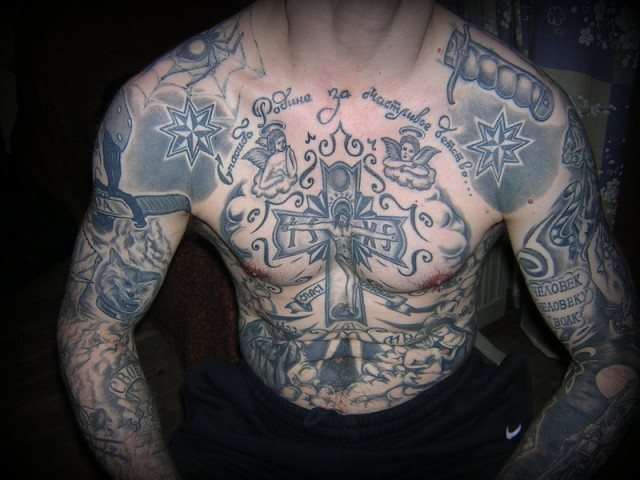

Prison symbolism is very developed and unusual. It is from prison came the fashion to give importance to the place of application of the cross. In the zone thieves (namely women) inflicted small crosses on the face and fingers, such a "professional" mark.
Another image used is a cross with the head of Jesus and the signature "freedom" in the fire. This tattoo means that its bearer is totally disillusioned with the world. His belief that he could live in freedom is "burned out," as is his belief in divine help.
And another curious prison tattoo is a crucified Virgin Mary with a baby in her arms. Such a tattoo means that a man will not betray his own and protect until his last breath.
It is impossible to tell all about the cross as a symbol, simply because there is no more polysemantic symbol, so easily expanding the list of its meanings and so easily acquire new meanings in combinations.
